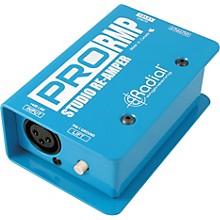
If you try going from a -20dBu guitar signal to a 30dBu mic signal, the -12dBu will give you -32dBu, which would be quite nice. In that scenario, the input signal would be significantly hotter than the expected output.Īlternatively, let’s assume you’re running the DI box the usual way and stepping down a ratio of 4:1. Now, suppose you have a line output of 600 ohms and OdBu. Let’s describe how that occurs using a hypothetical scenario: DI Box in Reverse: A Hypothetical ScenarioĪssume you have a DI box that can convert a signal from 1-milliohm impedance and -20dBu decibels to a 1.5-kiloohm impedance and -30dbU. When you connect a DI box in reverse, you’ll likely hear several distortions and noises in the reproduced sound. You may think, “Great! I’ll take my DI box and run it in reverse now!”

Take the clean guitar track you initially recorded and send it back through the DI in reverse by connecting your mixer’s output to the DI box XLR output.Place a mic in front of the guitar amp in the usual way, and then record another track.Connect the balanced output on the DI box directly to the mixer and record a clean guitar track.Plug the guitar into the direct injection box and send the throughput to the guitar amp.In that scenario, you’d follow these steps: Steely Dan, the Beatles, and Les Paul are examples of artists who’ve used DI boxes in reverse.įor example, say you want to reamp a heavy guitar using a passive DI box. Using this type of device for reamping isn’t new. In other words, is a direct box a two-device solution? Can you use it as a reamp?Īs we mentioned earlier, you can use a passive DI box in reverse. Passive DI Box: Which Is Right for Me? Are DI Boxes Bi-Directional? The Radial JDI is a popular example of a great passive direct box. The Radial J48 is an example of this type of DI box.Ĭonversely, a passive direct injection box doesn’t need a power source to function it acts as a transformer. You can power it with a battery, a phantom power source, or a dedicated AC supply. In the simplest terms, an active direct box requires power to function. Passive: What Are the Differences?Īlthough DI boxes come in different shapes and sizes, they can be either active or passive. So, a DI box is great for reducing unwanted noises from those kinds of sources.Īlso Read: Do You Need a DI Box if You Have a Preamp? Active vs. To achieve clean sound reproduction, audio engineers need to convert the high impedance signals from a musical instrument’s cable to a low-impedance signal that can run into the mixing board without degrading the signal. However, balanced wires with low resistance (low impedance) tend to produce less noise.

This may lead to signal degradation, causing undesired noise. When using electronic musical instruments, there will almost certainly be some electrical resistance (unbalanced high-impedance audio).

It allows you to connect musical instruments to the mixing board during audio production without distorting the sound signals. What Is a DI Box and Why Do I Need One?Ī direct injection (DI) box, also called a direct box, is an electronic device that converts high impedance signals to low impedance signals.

A great passive direct box from Radial Engineering.
#Signal art reamp how to
Read on for more information on the function of a DI box, types of DI boxes, and how to reduce the output signal level when using this device in reverse. Avoid such dirty sound by using an attenuator, like an H-pad, which reduces the signal level of the output, producing crisp sound. However, the reproduced sound will have plenty of distortion and noises, ruining your listening experience. But do you see those same results if you connect your DI box in reverse? Without a doubt, a DI box comes in handy by transforming unbalanced signals to balanced, producing clean, distortion-free audio. There are countless arguments both for and against using a DI box in reverse.


 0 kommentar(er)
0 kommentar(er)
